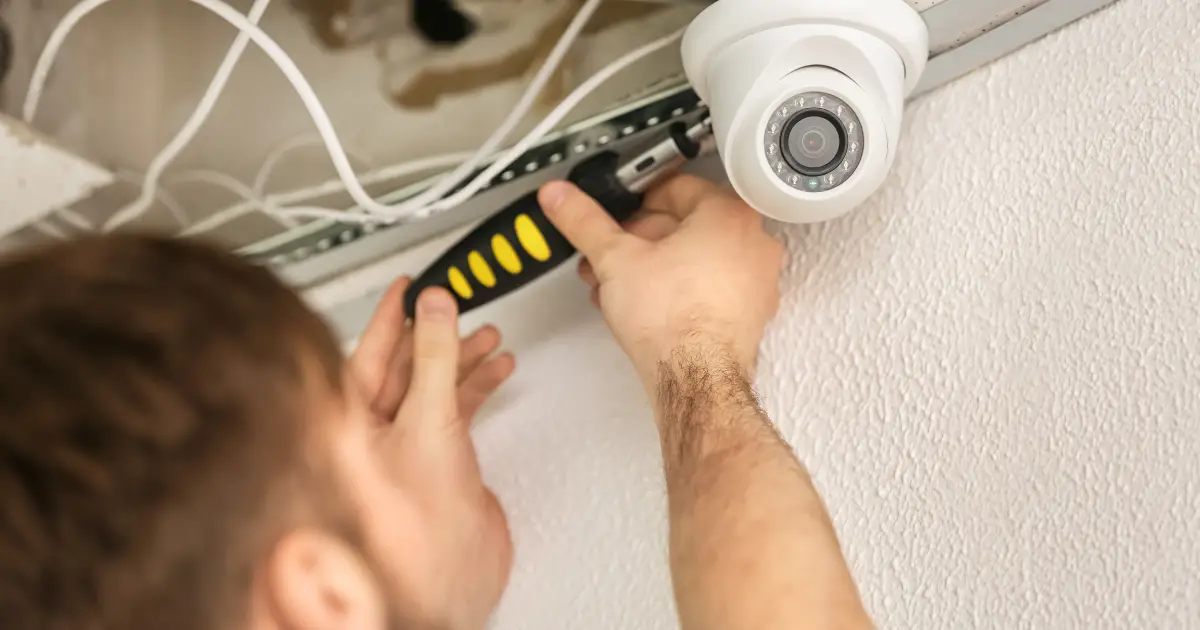Installing security camera wiring requires careful planning and understanding of the necessary equipment and techniques involved. To successfully install security camera wiring, you need to follow specific steps and guidelines to ensure a reliable and effective system.

Credit: www.youtube.com
Why Install Security Camera Wiring?
Installing security camera wiring is crucial for maintaining a safe and secure environment. Professional installation is of utmost importance to ensure reliable operation and maximize the benefits of security camera systems. By avoiding commonly overused phrases, such as “when it comes to” or “if you,” the writing becomes concise and engaging.
The significance of professional installation cannot be overstated, as it guarantees that the security cameras are correctly positioned and connected. This ensures optimal coverage and reduces the risk of blind spots. The benefits of installing security camera wiring include improved surveillance capabilities, enhanced deterrence against criminal activities, and increased peace of mind for both residential and commercial properties.
Therefore, it is essential to invest in professional installation for ensuring a seamless and effective security camera system.
Steps to Install Security Cameras Wiring
Planning For Security Camera Wiring Installation
Planning for security camera wiring installation involves evaluating your property for camera placement options. Assess potential areas where cameras can cover. Choose the right type of security cameras for your needs. Determine the number of cameras required for complete surveillance.
Create a wiring plan to ensure optimal coverage. Consider factors like distance, power source, and accessibility. Place cameras strategically to monitor vulnerable areas. Run wiring neatly and discreetly to avoid visibility. Proper planning ensures a successful security camera installation. Following these steps guarantees enhanced safety and peace of mind.
Tools And Materials Needed
Installing security camera wiring requires a specific set of tools and materials. The essential tools needed include a power drill, screwdriver, wire stripper, and tape measure. Additionally, you’ll need cable connectors, electrical tape, and a ladder for installation. When it comes to wiring materials, it is recommended to use high-quality cat5e or cat6 ethernet cables.
These cables are durable and can transmit data efficiently over long distances. Avoid using low-quality cables as they may lead to signal loss or interference. By following these guidelines, you can ensure a proper installation of security camera wiring for your home or business.
Remember to carefully plan and measure the layout before proceeding with the installation.
Preparing The Wiring Pathway
Inspecting the walls and ceilings reveals suitable wiring routes for security camera installation. Clearing any obstructions is necessary before creating a pathway. Make sure to map out the wiring route for each camera location. By following these steps, the process of installing security camera wiring can be successfully accomplished.
Running The Wiring
Choosing between wired and wireless cameras is the first step in installing security camera wiring. For wired cameras, you’ll need to select suitable cables that can transmit both power and video signals reliably. Running the wiring can be a challenging task, especially when it involves passing through walls, attics, and crawl spaces.
To ensure a neat and professional-looking installation, conceal and protect the wires by using wire clips, conduits, or even painting them to match the surroundings. Remember to follow safety guidelines and consult a professional if necessary. By carefully installing security camera wiring, you can enhance the security of your property and have peace of mind.
Connecting The Cameras And Dvr
Connecting security camera wiring involves terminating the wires to their respective camera and dvr connections. Next, configuring the dvr and cameras is necessary for proper functionality. This includes adjusting settings and ensuring proper communication between the devices. Once the wiring is connected and the devices are configured, it is important to test the camera system for optimal performance.
This involves verifying that the cameras are capturing clear and sharp footage and that the dvr is recording and storing the footage effectively. Regular testing and maintenance are crucial to ensure that the security camera system is functioning as intended and providing the necessary surveillance and security for your property.
Following these steps will help you install security camera wiring efficiently and effectively.
Troubleshooting And Maintenance
Regular maintenance is key to keeping your security camera wiring system functioning optimally. Taking care of common issues promptly can prevent major problems. Begin by checking all the connections and ensuring they are securely fastened. Inspect the cables for any signs of wear or damage and replace them if necessary.
Use a cable tester to verify that the wiring is properly installed and functioning as intended. If you encounter any issues, such as a loss of signal or poor video quality, troubleshoot by resetting the camera’s settings or adjusting the position of the camera.
Regularly cleaning the lenses and removing any debris or dust can also improve the camera’s performance. By following these maintenance tips, you can ensure your security camera system is reliable and provides the necessary protection for your property.
Frequently Asked Questions
How Do I Choose The Right Security Camera Wiring?
To choose the right security camera wiring, consider factors like distance, environment, and power requirements.
Can I Install Security Camera Wiring Myself?
Yes, you can install security camera wiring yourself if you have basic electrical knowledge and follow proper guidelines.
What Tools Do I Need To Install Security Camera Wiring?
You will need tools like a power drill, wire strippers, connectors, cable clips, and a cable tester.
Where Should I Route The Security Camera Wiring?
The security camera wiring should be routed discreetly along walls, ceilings, or in conduit for a neat and hidden installation.
How Should I Secure The Security Camera Wiring?
Secure the security camera wiring by using cable clips, zip ties, or conduit to prevent it from getting damaged or tampered with.
Final Thought
Installing security camera wiring is a crucial step in ensuring the effectiveness of your surveillance system. With the right tools and a solid plan, you can easily set up the necessary wiring to connect your cameras to the recording equipment.
Remember to carefully measure the distance between each camera and the recording device to ensure proper video signal transmission. Use high-quality cables and connectors to minimize signal loss and interference. Additionally, always follow safety guidelines when working with electrical wiring and consider hiring a professional if you are unsure about any aspect of the installation process.
By taking the time to install security camera wiring correctly, you can enhance the security of your property and have peace of mind knowing that your surveillance system is optimized for maximum effectiveness.

